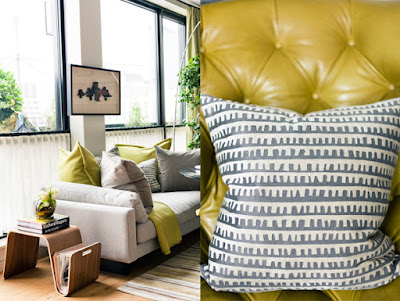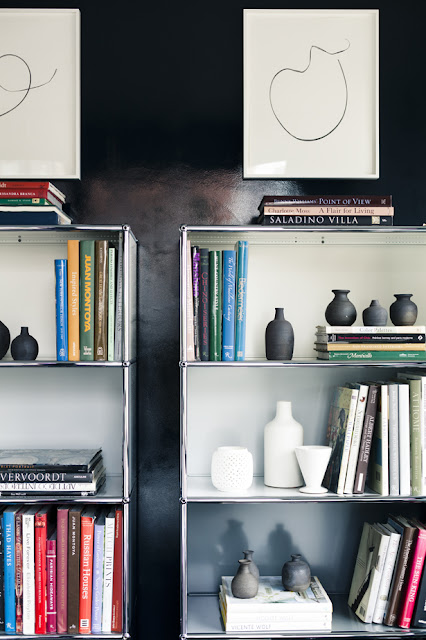Picked up two pairs of these neat earrings in black and teal from here...
Etruscans at Nat Geo: Cultural Exchange for Cash
Today, I had the opportunity to visit an exhibit about the Etruscans at the National Geographic Society. See http://events.nationalgeographic.com/events/exhibits/2011/06/10/etruscans/
The artifacts came from the Cambi Collection and National Museum of Archaeology, Florence, Italy, but the exhibit itself seems to be some sort of commercial venture. See
http://www.exhibitsdevelopment.com/brochures/Etruscan%20pagebypage.pdf
There were some interesting artifacts, but most of them were frankly second rate. The interpretive material was fine, but no brochures were to be found anywhere. And it cost $8 to enter ($6 for Nat Geo members).
This is still all fine and good, but I hope the Italians and the State Department are not going to claim this exhibit was sent as a gesture of good will due to the MOU imposing import restrictions on Italian cultural goods. Instead, the motivation appears to be collecting cold, hard cash.
The artifacts came from the Cambi Collection and National Museum of Archaeology, Florence, Italy, but the exhibit itself seems to be some sort of commercial venture. See
http://www.exhibitsdevelopment.com/brochures/Etruscan%20pagebypage.pdf
There were some interesting artifacts, but most of them were frankly second rate. The interpretive material was fine, but no brochures were to be found anywhere. And it cost $8 to enter ($6 for Nat Geo members).
This is still all fine and good, but I hope the Italians and the State Department are not going to claim this exhibit was sent as a gesture of good will due to the MOU imposing import restrictions on Italian cultural goods. Instead, the motivation appears to be collecting cold, hard cash.
Smithsonian Caves on Shiprwreck Exhibit
The New York Times reports that the Smithsonian Institution has indefinitely postponed its plans to mount an exhibition of Chinese artifacts salvaged from a shipwreck because of opposition from archaeologists who say the objects were collected by a commercial treasure hunter in a manner that violated professional standards. See http://artsbeat.blogs.nytimes.com/2011/06/28/shipwreck-show-postponed/
The Smithsonian has a long history of caving into various interest groups so this is not a surprise. But it is an unfortunate decision nonetheless.
The public could have learned something useful about early international trade whether or not the exhibit met the stringent standards of some in the archaeological community.
If the material cannot be exhibited as a group, perhaps it should be sold off wholesale to collectors just to annoy these archaeological purists.
The Smithsonian has a long history of caving into various interest groups so this is not a surprise. But it is an unfortunate decision nonetheless.
The public could have learned something useful about early international trade whether or not the exhibit met the stringent standards of some in the archaeological community.
If the material cannot be exhibited as a group, perhaps it should be sold off wholesale to collectors just to annoy these archaeological purists.
SAFE President Curates Show of "Stolen" Chinese Art?
Saving Antiquities for Everyone has championed the return of artifacts to China that were removed from the country during periods of turmoil.
So I find it a bit odd that SAFE's President has curated a show at the Rubin Museum comprised of art some repatriationists might consider "stolen." See
http://www.observer.com/2011/06/quentin-roosevelt%e2%80%99s-china-ancestral-realms-of-the-naxi-at-the-rubin-museum-of-art/2/
One wonders if the art in question was legally exported from China based this description of its transit from the country:
Leaving China with 20 trunks full of scrolls, manuscripts and skins of exotic animals like golden monkeys, pandas and snow leopards was tricky for Mr. Roosevelt due to the war then being waged between China and Japan; his exit was made possible through a family connection to a certain W. Langhorne Bond, then vice president of the Chinese National Airline; Mr. Roosevelt flew disguised as a steward.
I also find it refreshing that its removal is justified as an act of saving it from likely destruction from the depredations of the Chinese Communists and Japanese Militarists, but don't SAFE members criticize collectors and museums for making such arguments?
In any event, I wonder if Ms. Ho demanded that the Roosevelt family show her export certificates before she decided to curate the show....
Addendum: This post evidently struck a nerve (see comments). There is also a question whether China's 1935 Antiquities law applied to the Naxi artifacts in question as artifacts of "other cultures" that may not be sold to "aliens." I copy it below in full. The reader can judge for themselves:
RELICS PRESERVATION LAW
Enacted by the Legislative Yuan and
Promulgated by the National Government on June 2, 1930.
Amended on November 10, 1935.
Article 1. The term "relics" as denoted in this Law shall mean those related to archaeology, science of history, palaeontology and other cultures.
The sphere and categories of aforesaid
relics shall be determined by the Central Relics Custodian Commission.
Article 2. Except for those privately-owned, relics shall be preserved under the custody of offices to be specially assigned by the Central Relics Custodian Commission.
Article 3. Photographs of lasting nature of relics which are preserved in the following offices shall be taken by the custodian offices and deposited separately with the Ministry of Education, the Ministry of Interior, the Central Relics Custodian Commission and the office in which such
relics are preserved:
1) The institution directly under the jurisdiction of the central government.
2) The provincial, municipal, hsien, or other local institution.
3) The monasteries or temples or at the places where the ancient remains are located.
Article 4. Offices having custody of relics shall anually submit tables and reports to the Ministry of Education, Ministry of Interior, Central Relics Custodian Commission and local administrative authorities concerned. Forms of aforesaid tables and reports shall be proscribed by the Central Relics Custodian Commission.
Article 5. Privately-owned important relics shall be registered with the local administrative authorities concerned who shall, in turn, collectively report to tte Ministry of Edu:ation, Ministry of Interior and Central Relics Custodian Commission. The standard of the important relics abovementioned shall be determined by the Central Relics Custodian Commission.
Article 6. Privately-owned relics aforesaid that should be registered shall not be transferred to aliens. Offenders shall be liable to the confiscation of their relics and required to pay their cost if confiscation is not feasible.
Article 7. Relics hidden underground and those exposed above the ground shall be reverted to the State. Upon discovery of aforesaid relics, those who discovered such shall immediately report to the local administrative authorities concerned who shall request, through their superior authorities, the Ministries of Education and Interior and the Central Relics Custodian Commission to take over such relics, for which appropriate reward shall be granted. Whoever conceals such relics without reporting shall be dealt with as in the offences of theft.
Article 8. The excavation of relics shall be executed by academic institutiins directly under the central or local governments. For the excavation of relics, an academic institution aforesaid shall ask the Central Relics Custodian Commission to examine its application and to request the Ministries of Education and Interior to jointly issue an excavation permit.
Whoever excavates without the sforesaid permit shall be dealt with as in the offences of theft.
Article 9. Organic regulations of the Central Relics Custodian Commission shall be drawn up separately.
Article 10. Any academic institution directly under the central or a local government which requires the participation and assistance of any foreign academic organization or specialized
personnel in the excavation of relics shall request for prior approval of the Central Relics Custodian Commission.
Article 11. The excavation of relics shall be carried out under the supervision of officers of the Central Relics Custodian eommission.
Article 12. With respect to the relics procured from excavation, academic institutions directly under the central or local governments shall, subject to the approval of the Central Relics Custodian Commission, assume responsibility for the preservation, for a designated period, of the relics for academic research purposes.
Article 13. The circulation of relics shall be limited within the country. Eowever, if any academic institution directly under the central or local government finds it necessary to send its officers to bring relics abroad for research purposes, it shall apply for the authorization
of the Central Relics Custodian Commission who shall request the Ministries of Education and Interior to jointly issue an export permit. Relics brought abroad shall be returned to the
original custodien offices within two years, at the latest.
The provisions of the foregoing two paragraphs shall be applicable to privately-owned relics of which registration is required.
Article 14. The date of enforcement of the present Law shall be designated by mandate.
Addendum II:
I received the below letter from Ms. Roussin, a lawyer associated with SAFE. Here is my response. Her letter is further below:
Ms. Roussin- The blog posting you reference did not indicate I thought the material was stolen; it indicated that under various theories espoused by SAFE members it could be deemed stolen. The reference to the exit of the material was taken from a Newspaper article that was used as publicity for the show. I�ve already given Ms. Ho an opportunity to post a response to the blog. I have no objection to posting this letter as well. I�m sure you agree that the reader can draw their own conclusions. Best regards, Peter Tompa
As an additional note, rereading my original blog, it only referenced repatriationists considering such material stolen. I certainly don't personally believe the artifacts were stolen and am happy that they were put on display. The point here which Ms. Roussin apparently chooses to ignore is that SAFE's President and her organization should be as chartiable to other collectors as she has been to Mr. Roosevelt's collecting.
In any event, here is the letter:
Dear Mr. Tompa,
Various statements entitled "SAFE President Curates Show of "Stolen" Chinese Art?" published by you on your blog Cultural Property Observer of June 28, 2011 concerning the exhibition "Quentin Roosevelt's China: Ancestral Realms ofthe Naxi," now on display at the Rubin Museum of Art in New York, are false and close enough to defamation of character to be actionable. I demand that you remove the entire post and all comments that are displayed on your blog in response to your post immediately.
Phrasing your statement - suggesting that objects now owned by members of the Roosevelt family, on exhibit at the Peabody Museum of Archaeology and Ethnology, the Harvard Yenching Library and other institutions, and now on display at the Rubin Museum were somehow "stolen" is blatantly false. Your statement on your blog is false and was published by you with the obvious intent of injuring another person's reputation and without regard for the true facts, which you could have easily discovered by viewing the exhibition, or by reading the exhibition catalogue, or by consulting other published works that are referenced in the exhibition catalogue.
Rather than visit the exhibition, or consult the exhibition catalogue or other published works referenced therein, your sole source appears to be a false statement published in The New York Observer. The statement you quote - "Leaving China with 20 trunks full of scrolls, manuscripts and skins of exotic animals like golden monkeys, pandas and snow leopards was tricky for Mr. Roosevelt due to the war then being waged between China and Japan; his exit was made possible through a family connection to a certain W. Langhorne Bond, then vice president of the Chinese National Airline; Mr. Roosevelt flew disguised as a steward."- is false in four ways as follows.
Roosevelt's departure from China in 1939 was not "tricky," no airplane was involved, Roosevelt did not leave China posing as a steward, and W. Langhorne Bond played no part whatsoever. Roosevelt and his 20 suitcases departed Lijiang after 10 days of collecting Naxi artifacts, and traveled to Kunming in a motor coach provided by the head of the Southwest Transportation Company, Mr. T.L. Soong, who was the
brother of Madame Chiang Kai-Shek, the "first lady" of China. From Kunming, Roosevelt continued south to Haiphong on the Yunnan-Vietnam Railway in a private railroad car provided by a Mr. Patou, who was the head of railway. From Haiphong, Roosevelt continued on by steamer to Hong Kong, where he and his 20 suitcases boarded a ship called the Empress of China and sailed to San Francisco. See Martin Brauen, "A Memorable Journey to the Naxi: Quentin Roosevelt's Legacy," in Quentin Roosevelt's China: Ancestral Realms of the Naxi, 2011, page 36, and Quentin Roosevelt, "In the Land of the Devil Priests," in Natural History, April 1940, pages 208-209. These are the real facts that readers will find in the exhibition catalogue; the story that appears in The New York Observer, which you repeat in your blog post, is false, as the posted comments from Cindy Ho indicates.
The question you raise about "export certificates" for the Naxi objects that Quentin Roosevelt acquired in 1939 is answered by the very 1930 law that you quote in your revised blog post as well as the objects on display at the exhibition and various references in the exhibition catalog. The 1930 Relics Preservation Law, amended in 1935, governed the export of ancient objects, not objects made during the 19th and 20th centuries. Every Naxi object acquired by Quentin Roosevelt in 1939, and every Naxi object on display at the Rubin Museum, with one exception, dates from the 19th or 20 century, the sole exception being a scroll that Quentin Roosevelt's father acquired in China in 1928, two years before the law you cite was enacted. (See Martin Brauen, ibid., page 28). Therefore, no export certificate was required for anything on display at the exhibition. It is worth noting that prior to embarking on his l O-day collecting trip to Lijiang, Quentin Roosevelt met in Chongqing with Dr. H.H. Kung, President of the Executive Yuan that enacted the law you cite. Roosevelt's letters of introduction made the purpose of his trip clear. After that meeting in Chongqing. Dr. Kung promised Roosevelt safe passage through the restricted Yunnan regions. General Sze Hwa, a garrison commander for the northwestern frontier of Yunnan Province, and 40 armed Chinese soldiers accompanied Roosevelt to Lijiang. (See Martin Brauen, ibid., pages 32-34). Your suggestion that Roosevelt somehow "stole" Naxi objects under these circumstances is absurd. Your suggestion that curators of the Rubin Museum exhibition did not perform due diligence in this matter is damages their reputation and is
defamatory. and must be removed from your blog.
Finally, the organization SAFE/Saving Antiquities for Everyone had no part in the research, planning and development or any other curatorial interest in the Rubin Museum exhibition. Therefore SAFE's position on Chinese or any other antiquities is irrelevant, and use of the organization's name is an egregious error at best. In any case, your characterization of SAFE's position is incorrect; SAFE's position on these matters, which has not changed since its inception, can be found at http://www.savingantiquities.org/principles.php
Please inform me and SAFE president Cindy Ho when you have corrected or removed this posting.
Sincerely,
Lucille A. Roussin
So I find it a bit odd that SAFE's President has curated a show at the Rubin Museum comprised of art some repatriationists might consider "stolen." See
http://www.observer.com/2011/06/quentin-roosevelt%e2%80%99s-china-ancestral-realms-of-the-naxi-at-the-rubin-museum-of-art/2/
One wonders if the art in question was legally exported from China based this description of its transit from the country:
Leaving China with 20 trunks full of scrolls, manuscripts and skins of exotic animals like golden monkeys, pandas and snow leopards was tricky for Mr. Roosevelt due to the war then being waged between China and Japan; his exit was made possible through a family connection to a certain W. Langhorne Bond, then vice president of the Chinese National Airline; Mr. Roosevelt flew disguised as a steward.
I also find it refreshing that its removal is justified as an act of saving it from likely destruction from the depredations of the Chinese Communists and Japanese Militarists, but don't SAFE members criticize collectors and museums for making such arguments?
In any event, I wonder if Ms. Ho demanded that the Roosevelt family show her export certificates before she decided to curate the show....
Addendum: This post evidently struck a nerve (see comments). There is also a question whether China's 1935 Antiquities law applied to the Naxi artifacts in question as artifacts of "other cultures" that may not be sold to "aliens." I copy it below in full. The reader can judge for themselves:
RELICS PRESERVATION LAW
Enacted by the Legislative Yuan and
Promulgated by the National Government on June 2, 1930.
Amended on November 10, 1935.
Article 1. The term "relics" as denoted in this Law shall mean those related to archaeology, science of history, palaeontology and other cultures.
The sphere and categories of aforesaid
relics shall be determined by the Central Relics Custodian Commission.
Article 2. Except for those privately-owned, relics shall be preserved under the custody of offices to be specially assigned by the Central Relics Custodian Commission.
Article 3. Photographs of lasting nature of relics which are preserved in the following offices shall be taken by the custodian offices and deposited separately with the Ministry of Education, the Ministry of Interior, the Central Relics Custodian Commission and the office in which such
relics are preserved:
1) The institution directly under the jurisdiction of the central government.
2) The provincial, municipal, hsien, or other local institution.
3) The monasteries or temples or at the places where the ancient remains are located.
Article 4. Offices having custody of relics shall anually submit tables and reports to the Ministry of Education, Ministry of Interior, Central Relics Custodian Commission and local administrative authorities concerned. Forms of aforesaid tables and reports shall be proscribed by the Central Relics Custodian Commission.
Article 5. Privately-owned important relics shall be registered with the local administrative authorities concerned who shall, in turn, collectively report to tte Ministry of Edu:ation, Ministry of Interior and Central Relics Custodian Commission. The standard of the important relics abovementioned shall be determined by the Central Relics Custodian Commission.
Article 6. Privately-owned relics aforesaid that should be registered shall not be transferred to aliens. Offenders shall be liable to the confiscation of their relics and required to pay their cost if confiscation is not feasible.
Article 7. Relics hidden underground and those exposed above the ground shall be reverted to the State. Upon discovery of aforesaid relics, those who discovered such shall immediately report to the local administrative authorities concerned who shall request, through their superior authorities, the Ministries of Education and Interior and the Central Relics Custodian Commission to take over such relics, for which appropriate reward shall be granted. Whoever conceals such relics without reporting shall be dealt with as in the offences of theft.
Article 8. The excavation of relics shall be executed by academic institutiins directly under the central or local governments. For the excavation of relics, an academic institution aforesaid shall ask the Central Relics Custodian Commission to examine its application and to request the Ministries of Education and Interior to jointly issue an excavation permit.
Whoever excavates without the sforesaid permit shall be dealt with as in the offences of theft.
Article 9. Organic regulations of the Central Relics Custodian Commission shall be drawn up separately.
Article 10. Any academic institution directly under the central or a local government which requires the participation and assistance of any foreign academic organization or specialized
personnel in the excavation of relics shall request for prior approval of the Central Relics Custodian Commission.
Article 11. The excavation of relics shall be carried out under the supervision of officers of the Central Relics Custodian eommission.
Article 12. With respect to the relics procured from excavation, academic institutions directly under the central or local governments shall, subject to the approval of the Central Relics Custodian Commission, assume responsibility for the preservation, for a designated period, of the relics for academic research purposes.
Article 13. The circulation of relics shall be limited within the country. Eowever, if any academic institution directly under the central or local government finds it necessary to send its officers to bring relics abroad for research purposes, it shall apply for the authorization
of the Central Relics Custodian Commission who shall request the Ministries of Education and Interior to jointly issue an export permit. Relics brought abroad shall be returned to the
original custodien offices within two years, at the latest.
The provisions of the foregoing two paragraphs shall be applicable to privately-owned relics of which registration is required.
Article 14. The date of enforcement of the present Law shall be designated by mandate.
Addendum II:
I received the below letter from Ms. Roussin, a lawyer associated with SAFE. Here is my response. Her letter is further below:
Ms. Roussin- The blog posting you reference did not indicate I thought the material was stolen; it indicated that under various theories espoused by SAFE members it could be deemed stolen. The reference to the exit of the material was taken from a Newspaper article that was used as publicity for the show. I�ve already given Ms. Ho an opportunity to post a response to the blog. I have no objection to posting this letter as well. I�m sure you agree that the reader can draw their own conclusions. Best regards, Peter Tompa
As an additional note, rereading my original blog, it only referenced repatriationists considering such material stolen. I certainly don't personally believe the artifacts were stolen and am happy that they were put on display. The point here which Ms. Roussin apparently chooses to ignore is that SAFE's President and her organization should be as chartiable to other collectors as she has been to Mr. Roosevelt's collecting.
In any event, here is the letter:
Dear Mr. Tompa,
Various statements entitled "SAFE President Curates Show of "Stolen" Chinese Art?" published by you on your blog Cultural Property Observer of June 28, 2011 concerning the exhibition "Quentin Roosevelt's China: Ancestral Realms ofthe Naxi," now on display at the Rubin Museum of Art in New York, are false and close enough to defamation of character to be actionable. I demand that you remove the entire post and all comments that are displayed on your blog in response to your post immediately.
Phrasing your statement - suggesting that objects now owned by members of the Roosevelt family, on exhibit at the Peabody Museum of Archaeology and Ethnology, the Harvard Yenching Library and other institutions, and now on display at the Rubin Museum were somehow "stolen" is blatantly false. Your statement on your blog is false and was published by you with the obvious intent of injuring another person's reputation and without regard for the true facts, which you could have easily discovered by viewing the exhibition, or by reading the exhibition catalogue, or by consulting other published works that are referenced in the exhibition catalogue.
Rather than visit the exhibition, or consult the exhibition catalogue or other published works referenced therein, your sole source appears to be a false statement published in The New York Observer. The statement you quote - "Leaving China with 20 trunks full of scrolls, manuscripts and skins of exotic animals like golden monkeys, pandas and snow leopards was tricky for Mr. Roosevelt due to the war then being waged between China and Japan; his exit was made possible through a family connection to a certain W. Langhorne Bond, then vice president of the Chinese National Airline; Mr. Roosevelt flew disguised as a steward."- is false in four ways as follows.
Roosevelt's departure from China in 1939 was not "tricky," no airplane was involved, Roosevelt did not leave China posing as a steward, and W. Langhorne Bond played no part whatsoever. Roosevelt and his 20 suitcases departed Lijiang after 10 days of collecting Naxi artifacts, and traveled to Kunming in a motor coach provided by the head of the Southwest Transportation Company, Mr. T.L. Soong, who was the
brother of Madame Chiang Kai-Shek, the "first lady" of China. From Kunming, Roosevelt continued south to Haiphong on the Yunnan-Vietnam Railway in a private railroad car provided by a Mr. Patou, who was the head of railway. From Haiphong, Roosevelt continued on by steamer to Hong Kong, where he and his 20 suitcases boarded a ship called the Empress of China and sailed to San Francisco. See Martin Brauen, "A Memorable Journey to the Naxi: Quentin Roosevelt's Legacy," in Quentin Roosevelt's China: Ancestral Realms of the Naxi, 2011, page 36, and Quentin Roosevelt, "In the Land of the Devil Priests," in Natural History, April 1940, pages 208-209. These are the real facts that readers will find in the exhibition catalogue; the story that appears in The New York Observer, which you repeat in your blog post, is false, as the posted comments from Cindy Ho indicates.
The question you raise about "export certificates" for the Naxi objects that Quentin Roosevelt acquired in 1939 is answered by the very 1930 law that you quote in your revised blog post as well as the objects on display at the exhibition and various references in the exhibition catalog. The 1930 Relics Preservation Law, amended in 1935, governed the export of ancient objects, not objects made during the 19th and 20th centuries. Every Naxi object acquired by Quentin Roosevelt in 1939, and every Naxi object on display at the Rubin Museum, with one exception, dates from the 19th or 20 century, the sole exception being a scroll that Quentin Roosevelt's father acquired in China in 1928, two years before the law you cite was enacted. (See Martin Brauen, ibid., page 28). Therefore, no export certificate was required for anything on display at the exhibition. It is worth noting that prior to embarking on his l O-day collecting trip to Lijiang, Quentin Roosevelt met in Chongqing with Dr. H.H. Kung, President of the Executive Yuan that enacted the law you cite. Roosevelt's letters of introduction made the purpose of his trip clear. After that meeting in Chongqing. Dr. Kung promised Roosevelt safe passage through the restricted Yunnan regions. General Sze Hwa, a garrison commander for the northwestern frontier of Yunnan Province, and 40 armed Chinese soldiers accompanied Roosevelt to Lijiang. (See Martin Brauen, ibid., pages 32-34). Your suggestion that Roosevelt somehow "stole" Naxi objects under these circumstances is absurd. Your suggestion that curators of the Rubin Museum exhibition did not perform due diligence in this matter is damages their reputation and is
defamatory. and must be removed from your blog.
Finally, the organization SAFE/Saving Antiquities for Everyone had no part in the research, planning and development or any other curatorial interest in the Rubin Museum exhibition. Therefore SAFE's position on Chinese or any other antiquities is irrelevant, and use of the organization's name is an egregious error at best. In any case, your characterization of SAFE's position is incorrect; SAFE's position on these matters, which has not changed since its inception, can be found at http://www.savingantiquities.org/principles.php
Please inform me and SAFE president Cindy Ho when you have corrected or removed this posting.
Sincerely,
Lucille A. Roussin
Labels:
China,
China MOU,
Chinese artifacts,
Chinese law,
hypocrisy,
Repatriation,
SAFE
Fly me to the moon
Just sharing some of my fun from this weekend. My boyfriend and I celebrated our 10 year Anniversary!! (Yup I've been with my fella since I was 17) so we took to the skies. The fun isn't over yet I have a birthday Monday, so lots more fun, laughs and presents!!
Can an Effective Advocate Be a Good CPAC Chair?
CPAC's new Chair, Professor Patty Gerstenblith, has been a very effective and knowledgeable advocate for the archaeological cause. I've seen that for myself over the past decade from practicing before CPAC and serving with Prof. Gerstenblith in a leadership position in the ABA International Law Section's Art and Cultural Heritage Law Committee.
As Chair, Professor Gerstenblith's challenge will be to transition from acting solely as an advocate for the "context over all" archaeological position to ensuring that the Convention on Cultural Property Implementation Act is properly applied at CPAC and that all voices-- not just those of the archaeological community-- are heard and duly considered at CPAC meetings.
For CPAC to retain any relevance at all it will be critical for Professor Gerstenblith to make that transition. I'm confident she can do so, but she will certainly be up against the perceptions of both archaeologists and those opposed to the extension of import restrictions to even the most common artifacts, like ancient coins.
As Chair, Professor Gerstenblith's challenge will be to transition from acting solely as an advocate for the "context over all" archaeological position to ensuring that the Convention on Cultural Property Implementation Act is properly applied at CPAC and that all voices-- not just those of the archaeological community-- are heard and duly considered at CPAC meetings.
For CPAC to retain any relevance at all it will be critical for Professor Gerstenblith to make that transition. I'm confident she can do so, but she will certainly be up against the perceptions of both archaeologists and those opposed to the extension of import restrictions to even the most common artifacts, like ancient coins.
Obama Appoints Prof. Patty Gerstenblith to Chair CPAC
The Obama Administration has shown its support for the archaeological community by appointing Prof. Patty Gerstenblith Chair of the Cultural Property Advisory Committee. Professor Nancy Wilkie was also reappointed to represent the interests of the archaeological community on CPAC. See
http://www.whitehouse.gov/the-press-office/2011/06/24/president-obama-announces-more-key-administration-posts
The announcement does not state which interest group Prof. Gerstenblith will represent on CPAC. Presumably, Prof. Gerstenblith should represent the interests of the archaeological community, but it is also possible that the Obama Administration will designate her as a member representing the interests of the public.
In any event, it appears that the Obama State Department has decided to "solve" its "CPAC problem" by tilting CPAC to the extreme archaeological view adopted by the State Department Bureau of Educational and Cultural Affairs Cultural Heritage Center.
Opensecrets.org reports that Prof. Gerstenblith has donated $14,950 to Democratic candidates since 2008, including $2,300 to President Obama's election campaign and $1500 to his Senatorial campaigns.
http://www.whitehouse.gov/the-press-office/2011/06/24/president-obama-announces-more-key-administration-posts
The announcement does not state which interest group Prof. Gerstenblith will represent on CPAC. Presumably, Prof. Gerstenblith should represent the interests of the archaeological community, but it is also possible that the Obama Administration will designate her as a member representing the interests of the public.
In any event, it appears that the Obama State Department has decided to "solve" its "CPAC problem" by tilting CPAC to the extreme archaeological view adopted by the State Department Bureau of Educational and Cultural Affairs Cultural Heritage Center.
Opensecrets.org reports that Prof. Gerstenblith has donated $14,950 to Democratic candidates since 2008, including $2,300 to President Obama's election campaign and $1500 to his Senatorial campaigns.
Hypocrisy and Cronyism on Display at US Embassy in Cyprus
The Director the Cyprus American Archaeological Research Institute (CAARI) and the US Ambassador to Cyprus have dedicated a display of unprovenanced antiquities at the US Embassy. http://news.caorc.org/2011/06/caari-director-and-us-ambassador.html
The artifacts were apparently registered with the Cypriot authorities before they were displayed, but are said to be gifts from Cypriot citizens. There certainly is no suggestion that they are the products of scientific archaeological investigation.
Of course, CAARI has bragged that it was instrumental in lobbying the State Department for import restrictions on behalf of the Cypriot Department of Antiquities and the Assistant Secretary of State, Bureau of Educational and Cultural Affairs, approved the ban on US collectors obtaining such material from abroad.
Yes, hypocrisy and cronyism are indeed on display at the US Embassy in Cyprus along with those cases of unprovenanced Cypriot antiquities.
The artifacts were apparently registered with the Cypriot authorities before they were displayed, but are said to be gifts from Cypriot citizens. There certainly is no suggestion that they are the products of scientific archaeological investigation.
Of course, CAARI has bragged that it was instrumental in lobbying the State Department for import restrictions on behalf of the Cypriot Department of Antiquities and the Assistant Secretary of State, Bureau of Educational and Cultural Affairs, approved the ban on US collectors obtaining such material from abroad.
Yes, hypocrisy and cronyism are indeed on display at the US Embassy in Cyprus along with those cases of unprovenanced Cypriot antiquities.
Robert Korver on State Department Bureaucratic Overreach
Robert Korver has written an eye-opening article about his experiences on CPAC. See http://www.becounsel.com/wp-content/uploads/2011/06/Korver_Art_6_2011.pdf
In particular, Korver writes in Celator Magazine about his concerns that State Department bureaucrats aligned with archaeological interests have hijacked the process for imposing import restrictions on cultural goods. Celator Magazine publishes articles of interest to ancient coin collectors.
I should also note my gratitude to Mr. Korver for mentioning my work on behalf of collectors and the small businesses of the numismatic trade. (I've done legal work and lobbying for IAPN, PNG and ACCG-- some of it paid, a lot of it not.)
In particular, Korver writes in Celator Magazine about his concerns that State Department bureaucrats aligned with archaeological interests have hijacked the process for imposing import restrictions on cultural goods. Celator Magazine publishes articles of interest to ancient coin collectors.
I should also note my gratitude to Mr. Korver for mentioning my work on behalf of collectors and the small businesses of the numismatic trade. (I've done legal work and lobbying for IAPN, PNG and ACCG-- some of it paid, a lot of it not.)
US Military Spends a Million Dollars to Save Buddhist Artifacts from Chinese Miners
Does anyone else think something is wrong with this picture?
See
http://www.bbc.co.uk/news/world-south-asia-13717471
If ancient culture is so important to Afghanistan, why are the Afghans allowing a Chinese Mining Company to dynamite an important Buddhist archaeological site? And why is the US Military rather than the Chinese spending $ 1 million on rescue archaeology?
See
http://www.bbc.co.uk/news/world-south-asia-13717471
If ancient culture is so important to Afghanistan, why are the Afghans allowing a Chinese Mining Company to dynamite an important Buddhist archaeological site? And why is the US Military rather than the Chinese spending $ 1 million on rescue archaeology?
Ancient Coins and the Cultural Property Debate at the ANS
The American Numismatic Society (ANS) Magazine is carrying a feature about ancient coins and the cultural property debate. As the ANS notes in an email to members,
The ANS has a long tradition of scholarly numismatic research and publication, often based upon the availability of information about the source of ancient coins, and thus supports efforts to preserve contextual information. On the other hand, much of the membership of the ANS consists of coin collectors and dealers, who have a strong interest in preserving the right to collect ancient coins. In the interest of informing its membership (and the public at large) on the issues involved, we have inaugurated a series of articles in ANS Magazine on various topics relating to ancient numismatics and the cultural property debate. An extended version of the print article is available to view online. All subsequent articles within this column will be published online as well.
For an overview by Rick Witchonke and an archaeologist's perspective by Sebastian Heath, see http://numismatics.org/html/dpubs/nonxml/WitschonkeHeathFinal.pdf
In his overview, Witchonke rightly notes that aggressive application of cultural property laws has disincentivized the sharing of numismatic knowledge. Meanwhile, while I agree with Heath that we all benefit from information gleaned from the Frome hoard, it does not follow that the State should keep all coins once they are recorded or that it is a legal requirement to record all coins found in the UK. In fact, the Treasure Act sets forth the legal duties of finders while the Portable Antiquities Scheme is a voluntary program that encourages coins not legally required to be reported to be recorded. Finally, I commend Heath's desire for greater transparency in the US process for imposing import restrictions on cultural goods, but would nonetheless suggest such restrictions have little practical impact other than to punish those importers who seek to comply with the law.
My own perspective should follow in the next of the series.
The ANS has a long tradition of scholarly numismatic research and publication, often based upon the availability of information about the source of ancient coins, and thus supports efforts to preserve contextual information. On the other hand, much of the membership of the ANS consists of coin collectors and dealers, who have a strong interest in preserving the right to collect ancient coins. In the interest of informing its membership (and the public at large) on the issues involved, we have inaugurated a series of articles in ANS Magazine on various topics relating to ancient numismatics and the cultural property debate. An extended version of the print article is available to view online. All subsequent articles within this column will be published online as well.
For an overview by Rick Witchonke and an archaeologist's perspective by Sebastian Heath, see http://numismatics.org/html/dpubs/nonxml/WitschonkeHeathFinal.pdf
In his overview, Witchonke rightly notes that aggressive application of cultural property laws has disincentivized the sharing of numismatic knowledge. Meanwhile, while I agree with Heath that we all benefit from information gleaned from the Frome hoard, it does not follow that the State should keep all coins once they are recorded or that it is a legal requirement to record all coins found in the UK. In fact, the Treasure Act sets forth the legal duties of finders while the Portable Antiquities Scheme is a voluntary program that encourages coins not legally required to be reported to be recorded. Finally, I commend Heath's desire for greater transparency in the US process for imposing import restrictions on cultural goods, but would nonetheless suggest such restrictions have little practical impact other than to punish those importers who seek to comply with the law.
My own perspective should follow in the next of the series.
Misplaced Priorities?
AFP reports that Bulgarian authorites are spending up to 320,000 Euros to repatriate minor Bulgarian artifacts allegedly smuggled into Canada. See
http://www.france24.com/en/20110616-bulgaria-brings-home-smuggled-antiquities-canada#
As is the case with many similar reports, we'll never know the actual facts because the importer abandoned the property.
Meanwhile, Bulgarian archaeologists are lamenting their country's lack of care for its world class archaeological sites. See
http://www.novinite.com/view_news.php?id=128889 The report also claims that up to 300,000 Bulgarians are part time treasure hunters.
It seems to me Bulgarian money would be better spent on security for sites under active archaeological investigation and on a treasure trove program for the rest.
Reports of repatriations may be fodder for the likes of archaeo-bloggers David Gill and Paul Barford, but ultimately don't they also just serve as a distraction from the poor stewardship of countries like Bulgaria for their archaeological sites?
http://www.france24.com/en/20110616-bulgaria-brings-home-smuggled-antiquities-canada#
As is the case with many similar reports, we'll never know the actual facts because the importer abandoned the property.
Meanwhile, Bulgarian archaeologists are lamenting their country's lack of care for its world class archaeological sites. See
http://www.novinite.com/view_news.php?id=128889 The report also claims that up to 300,000 Bulgarians are part time treasure hunters.
It seems to me Bulgarian money would be better spent on security for sites under active archaeological investigation and on a treasure trove program for the rest.
Reports of repatriations may be fodder for the likes of archaeo-bloggers David Gill and Paul Barford, but ultimately don't they also just serve as a distraction from the poor stewardship of countries like Bulgaria for their archaeological sites?
Pretty Pictures
Lucky me I get to work with this uber talented photographer, aren't her photos just beautiful, have a look at more of her stuff here...
"Any chance of using any influence you might have to get all the Medici photos published?"
So asks the only collector congratulating Archaeo-blogger David Gill on his award from the AIA. See http://lootingmatters.blogspot.com/2011/06/archaeological-institute-of-america.html
But why should Gill accede to such a request? He's gained much of his notoriety by ambushing unsuspecting collectors and auction houses with pictures from the Medici archives that he evidently has special access to. During the CPAC hearing on a renewal of the Italian MOU, lawyer Bill Pearlstein asked CPAC to condition any renewal on making these pictures public so that this looted material could be identified by the market. We don't know if CPAC adopted that suggestion in its recommendations to ECA Assistant Secretary Ann Stock, but we do know that the State Department did not incorporate that reasonable request in the revised MOU with Italy.
So, David Gill should also give thanks to the Bureau of Educational and Cultural Affairs Cultural Heritage Center for allowing him to continue his game of "gotcha" and the notoriety embarrassing others gives him.
But why should Gill accede to such a request? He's gained much of his notoriety by ambushing unsuspecting collectors and auction houses with pictures from the Medici archives that he evidently has special access to. During the CPAC hearing on a renewal of the Italian MOU, lawyer Bill Pearlstein asked CPAC to condition any renewal on making these pictures public so that this looted material could be identified by the market. We don't know if CPAC adopted that suggestion in its recommendations to ECA Assistant Secretary Ann Stock, but we do know that the State Department did not incorporate that reasonable request in the revised MOU with Italy.
So, David Gill should also give thanks to the Bureau of Educational and Cultural Affairs Cultural Heritage Center for allowing him to continue his game of "gotcha" and the notoriety embarrassing others gives him.
Archaeo-Blogger David Gill Gets AIA's "Outstanding Public Service Award"
Anyone who has deluded himself into thinking that the AIA takes a "moderate stance" on collecting should take note: David Gill has announced on his own blog that the the AIA has given him its "Outstanding Public Service Award:" See
http://lootingmatters.blogspot.com/2011/06/archaeological-institute-of-america.html
In so doing, the AIA has indicated its support for Gill's brand of Internet Cultural Property Vigilantism where accusation is all too often confused with hard fact.
Apparently, the award recognises Gill's "ongoing efforts to educate both professional archaeologists and the public at large on the threats posed by the international antiquities trade".
Note the citation does not mention an "illicit" trade. Presumably, the AIA hardliners view the international antiquities trade to be "evil" in and of itself so "illicit" is just assumed. That certainly is the tact all too often taken by Professor Gill in his blog.
http://lootingmatters.blogspot.com/2011/06/archaeological-institute-of-america.html
In so doing, the AIA has indicated its support for Gill's brand of Internet Cultural Property Vigilantism where accusation is all too often confused with hard fact.
Apparently, the award recognises Gill's "ongoing efforts to educate both professional archaeologists and the public at large on the threats posed by the international antiquities trade".
Note the citation does not mention an "illicit" trade. Presumably, the AIA hardliners view the international antiquities trade to be "evil" in and of itself so "illicit" is just assumed. That certainly is the tact all too often taken by Professor Gill in his blog.
CPRI Files FOIA Request on Purported Egyptian Done Deal
The Cultural Policy Research Institute has requested the State Department and U.S. Customs and Border Protection to disclose documents about a purported MOU with Egypt engineered by a coalition of archaeological groups led by the Capitol Archaeological Institute. For more, see
http://www.cprinst.org/press/freedom-of-information-act-request
As a press release indicates,
The Cultural Policy Research Institute is deeply concerned by the implication that the actions of the Cultural Property Advisory Committee and the State Department�s Department of Cultural Affairs are being directed by a coalition archaeological lobbyists.
Dr. Hawass� description of their discussion strongly suggests that the statutory requirements of the Convention on Cultural Property Implementation Act (CCPIA) have been completely ignored and the decision-making role of the Cultural Property Advisory Committee to the President (CPAC) has been superseded.
The message is clear: a Memorandum of Understanding with Egypt would be initiated and drafted by a private U.S. group, not by the U.S. Government, as contemplated under the Cultural Property Implementation Act. The same private group has apparently guaranteed that the U.S government would sign an agreement with the Government of Egypt limiting access by all Americans to art from a founding civilization of the ancient world.
Will the State Department Bureau of Educational and Cultural Affairs Cultural Heritage Center and U.S. Customs come clean about delegating agreement authority to a private archaeological group? Or, will they stonewall as they have in the past?
http://www.cprinst.org/press/freedom-of-information-act-request
As a press release indicates,
The Cultural Policy Research Institute is deeply concerned by the implication that the actions of the Cultural Property Advisory Committee and the State Department�s Department of Cultural Affairs are being directed by a coalition archaeological lobbyists.
Dr. Hawass� description of their discussion strongly suggests that the statutory requirements of the Convention on Cultural Property Implementation Act (CCPIA) have been completely ignored and the decision-making role of the Cultural Property Advisory Committee to the President (CPAC) has been superseded.
The message is clear: a Memorandum of Understanding with Egypt would be initiated and drafted by a private U.S. group, not by the U.S. Government, as contemplated under the Cultural Property Implementation Act. The same private group has apparently guaranteed that the U.S government would sign an agreement with the Government of Egypt limiting access by all Americans to art from a founding civilization of the ancient world.
Will the State Department Bureau of Educational and Cultural Affairs Cultural Heritage Center and U.S. Customs come clean about delegating agreement authority to a private archaeological group? Or, will they stonewall as they have in the past?
Subscribe to:
Posts (Atom)
































